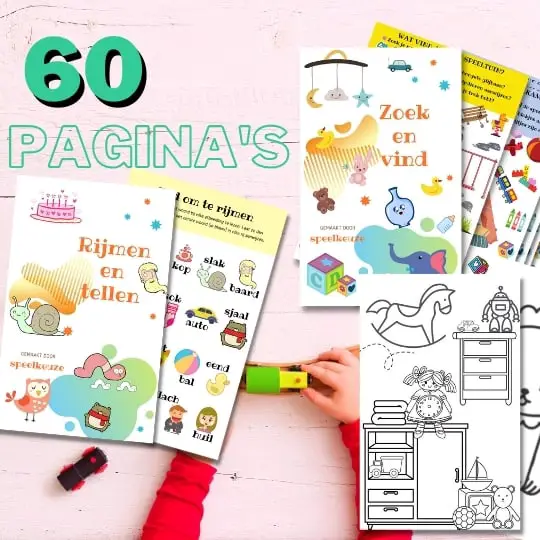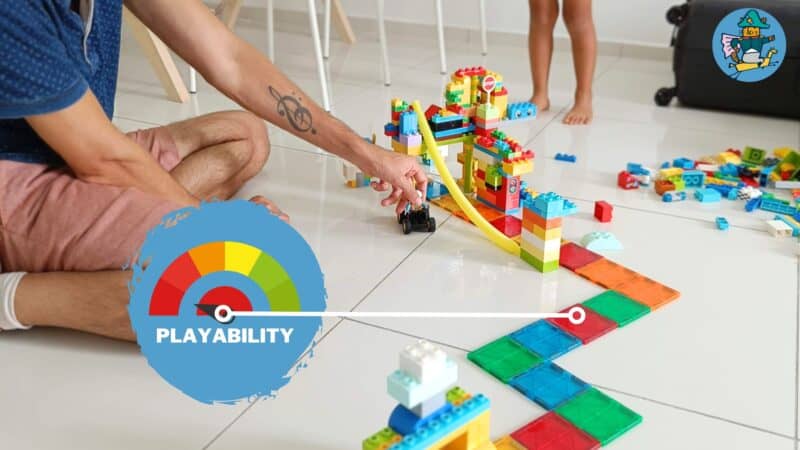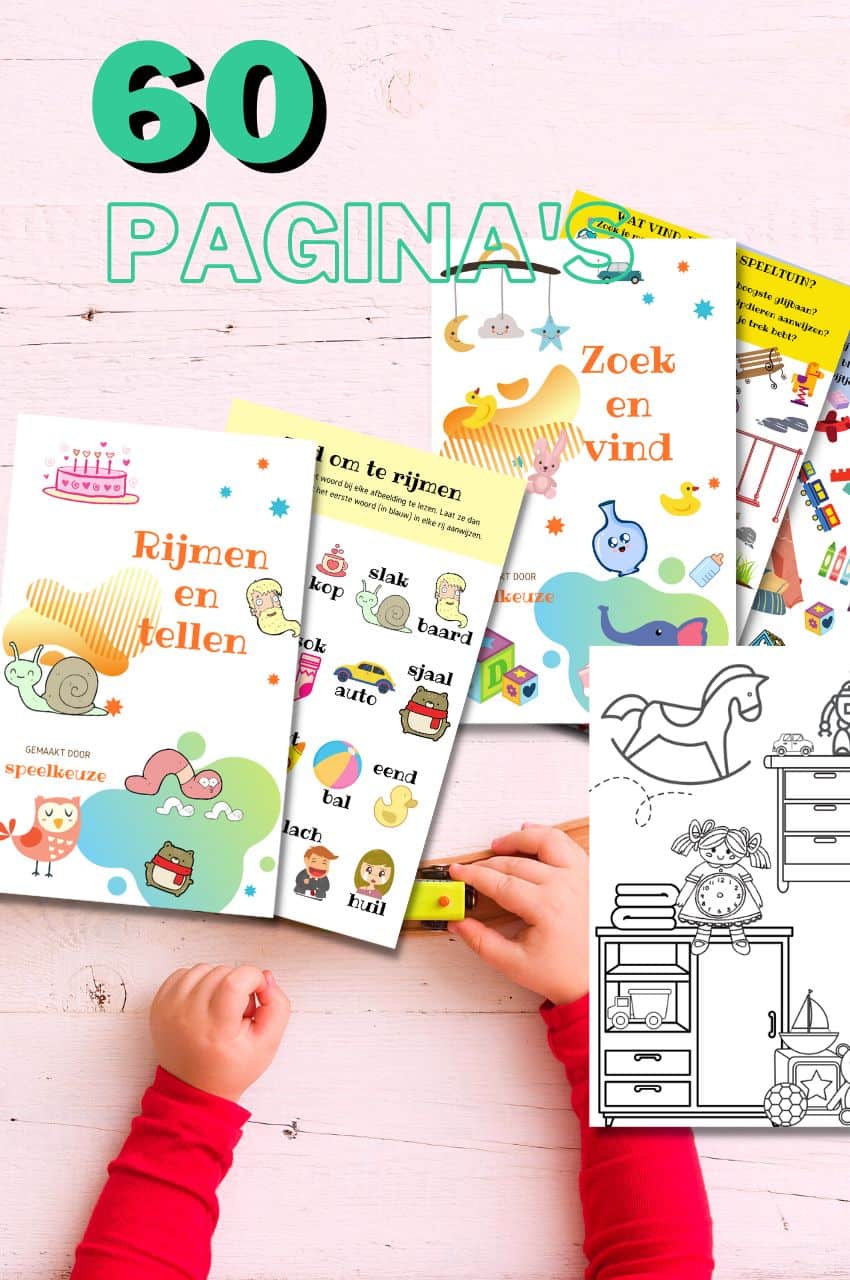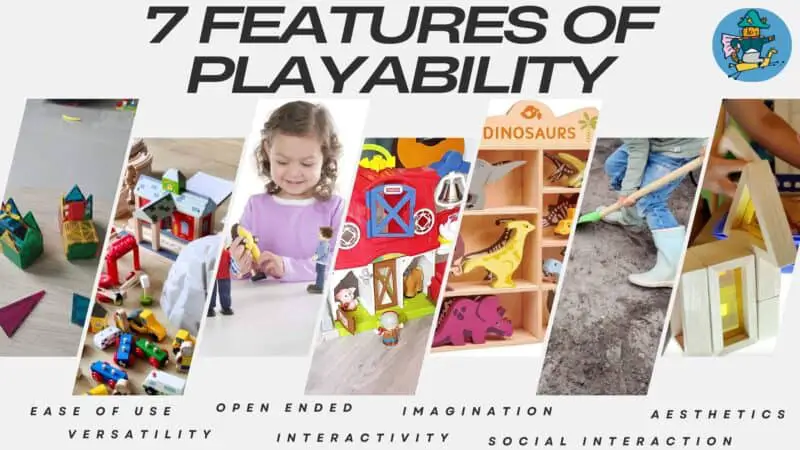7 essential features that make toys fun

Always something to do for the holidays or rainy day?
Play Choice now has the ultimate activity book collection, with over 60 pages of fun coloring pages and educational puzzles.

Play value of toys is the ability of toys to engage children and provide fun during play. This is determined by several factors, such as the creativity and open-ended nature of the toy.
A study conducted by Yi-he Li, Min-yuan Ma, and Wei-chen Li of National Cheng Kung University examined the relationship between children's temperament and the playability of toys across different categories. They classified toddlers based on temperament tests and selected representative toys according to Piaget's game theory.
The research identified five categories of toys: physical toys, role-play toys, building blocks, clay toys, and number play toys. It showed that children with different temperaments had different preferences when playing with these toy categories.
For example, children with different perseverance levels showed significant differences in role-playing and toys that create playable outcomes. Children with different distractibility also showed significant differences in role playing.
Although the play value of a toy is a little different for every child, I will nevertheless set a standard for its playability in this article. Whether the toy matches the theme preference, as well as the age of the child, fall outside the intrinsic attributes of the product and I therefore do not include it in the assessment.
The play value of toys is influenced by several important properties. Ease of use, versatility and open-endedness are the three most important features. These features allow children to develop their creativity, learn new skills and play with the toy in different ways.
Play value is an important contribution to the quality of toys. It determines how much fun a child can have while playing and how much positive development it can promote.

From toddler to toddler activity book collection
Educational games and coloring pages for 3 to 6 years
Your toddler and preschooler will love this e-book, along with the accompanying printables. He or she can play with it at every stage of development, together with mom and dad.
Buy at Bol.comWhat we discuss in this comprehensive post:
7 features of a toy that make it more fun than others
When I think of pure play value, I want to know if my child can have fun with the toy or if it will just sit in the corner without ever being used again.
Of course there are several characteristics that determine whether a toy is playable or not, such as safety and durability, but in my opinion those are separate properties of a toy that make it suitable for play.
My child is not going to say, "This toy is safe, so I'm going to have more fun with it."
Age appropriateness is another factor in being able to play with it, but it's not an inherent quality of a toy. It's more about the age range for which the toy is intended and, of course, if you give toys that are outside your child's age range, they will have less fun with them. Not because of the toy's inherent age-appropriateness.
I'll also touch on each of these additional factors that contribute to being able to play with a toy, but first I'd like to focus on the 7 inherent properties of a toy that make it more playable, as listed below.
- Ease of use (30%)
- Versatility (25%)
- Open ended play (15%)
- Interactivity (10%)
- Imagination and creativity (10%)
- Social interaction (5%)
- Aesthetic appeal (5%)
At Kids Toys Studio, we assess the play value of a toy based on the following formula of each of these characteristics of the toy.
Play value = Ease of use * 30% + Versatility * 25% + Open ended play * 15% + Interactivity * 10% + Imagination and creativity * 10% + Social interaction * 5% + Aesthetic appeal * 5%

#1 Ease of use
Ease of use is the extent to which a toy is easy for children to use. The design of the toy should be intuitive and clear so that it's easy for children to grasp and grab. The size and weight of the toy should be suitable for the child so that they can manipulate and play with it without any problems.
The toys should also be able to work without too much adult supervision so that children can play independently and not feel frustrated.
Visual cues and instructions can aid in navigating and manipulating the toy, increasing ease of use.
It's important that toys are easy to use, as it affects their playability. If a toy is difficult to use, it can hinder the child's play experience and cause them to become frustrated.
#2 Versatility
Versatility is the ability of a toy to be used in different ways. This gives more possibilities for play and also leads to more creative play sessions.
An example of this is what Yi-he Li, Min-yuan Ma and Wei-chen Li discovered in their research: that building blocks that can also become something else, such as a seat or something to play with, were given much more playtime than building materials that couldn't.
This is because the toy can be used in different ways. It was also important that the construction toys could be played with properly and that they could be moved without falling apart.
#3 Open ended play
Open-ended play is playing without set rules or restrictions. It's a play concept that gives children the freedom to play with toys in different ways and to develop their creativity and imagination.
The toy should offer different possibilities and allow children to play in multiple ways, as well as versatility. But it should also allow for collaboration and thinking outside the box.
Open-ended play allows children to create their own scenarios and make up their own rules, leading to longer play sessions.
#4 Interactivity
Interactivity is the ability of toys to engage the child in the play experience. Toys that encourage positive interaction and encourage children to engage improve the overall play experience.
But toys that stimulate children's sensory stimulation, such as colorful and interesting toys, also offer a pleasant playing experience. Especially for the little ones.
The interactivity that offers the most play value is based on direct and positive feedback and reward for the child's actions.
#5 Imagination and creativity
Imagination and creativity refer to children's ability to use their imagination and create new ideas.
The ability of toys to allow open play is again critical here. This means that the toy allows children to play in different ways and create their own stories.
In addition, toys that facilitate building and construction, as well as toys that encourage art and creativity, can greatly influence children's imagination and creativity. Examples of this are building blocks and craft sets.
Finally, toys that encourage breaking rules and boundaries can boost children's imagination and creativity. This can encourage children to explore new ideas and perspectives and develop their creative thinking skills.
#6 Social interaction
Social interaction is the process by which individuals communicate with each other, cooperate and engage in social activities. The possibility to play together with toys plays an important role in this.
Toys designed to be played in groups, such as board games or team games, encourage social interaction. In addition, the setting in which the toy is played can also have an influence. Toys that can be played indoors, such as board games, provide different opportunities for social interaction than toys that are played outdoors, such as sports.
#7 Aesthetic appeal
Aesthetic appeal refers to the design and aesthetic features that make the toy attractive to children. The colors, materials and overall visual appearance are important factors that influence a toy's aesthetics.
Bright and interesting design can attract children and arouse their interest. Wooden toys are often considered aesthetically pleasing due to the natural material and visual appeal.
The aesthetic appeal of a toy is important because it affects its play value. A visually appealing toy can attract children and increase their interest in playing.
What other features contribute to play value?
There are other characteristics of toys that affect higher level playability. Can a child safely play with the toy and can they take the toy anywhere to play are two good examples of this.
They don't necessarily make the toy more fun to play with, but add to the overall play value. The main features that contribute to the higher level playability are the following.
- Safety
- Age appropriateness
- Educational value
- Theme and personalization
- Portability and storage
Safety
Safety is about reducing risk and ensuring the protection of children. With toys, the design of the toy is important, minimizing potential hazards. It's more a requirement for good toy play than a factor that adds to the fun.
It's also very important that the toy doesn't contain small parts that could pose a choking hazard. Another important factor is that the toys are manufactured in a way that minimizes the risk of toxic substances.
By taking all these aspects into account, the safety of the toy is ensured.
Age appropriateness
Age appropriateness indicates which toys are suitable for which age group. It's not a score you can assign to a toy, but an indication of the age range for which the toy will be fun and safe.
First, toys should be safe and not a choking hazard for young children. Secondly, the toy must match the developmental stage of the child, such as motor skills and cognitive abilities. In addition, the toy should be challenging enough to stimulate the child's development, but not too difficult to avoid frustration.
It's important that toys are appropriate for the intended age group, as they help children to develop appropriately and have fun while playing.
Educational value
Educational value is the extent to which a toy contributes to the learning and development of children. The toys should be of scientific and higher level so that the child is challenged and can acquire new knowledge and skills. Second, it should provide the opportunity to combine entertainment and education so that the child has fun while learning.
So it's true that play value is part of the educational value, and not the other way around. It's important that toys are playable, as this increases the child's involvement and interest.
Theme and personalization
Theme and personalization is the concept of adapting toys to specific themes and personal preferences. This creates a unique and personalized play experience for children. It's very important for the playability of a toy, but not an intrinsic characteristic by which to judge it, because it differs for every child.
The theme is the specific subject or story the toy is based on, such as superheroes, animals or fairy tales. In addition, colors, patterns and designs can also contribute to the thematic elements of the toy.
Toys that match their interests and personalities will encourage them to actively participate in play.
Portability, travel friendliness and storage
Portability and storage is the ability of a toy to be easily transported and stored. The toy should be compact and light enough and while this contributes to how often and where you can play with it, it is not a factor that directly contributes to the play value. Rather, it is a contributing factor to replayability.
Several factors contribute to toy portability and storage. First, the size of the toy is important. Toys that are small and foldable are easy to take with you when traveling and takes up little space when storing. The weight of the toy is also important. Lightweight toys are easier to carry and move.
In addition, the materials of which the toy is made play a role. Toys made of durable and flexible materials can be folded or rolled up for easier storage. Toys with detachable parts can also be stored more compactly.
Play mode
The play mode of a toy refers to the way children can play with it, which affects their experience and development. There are three main play modes: solo play, cooperative play and competitive play.
Toys for independent play
Solo play toys are designed to keep children entertained independently. These toys encourage independent play and creativity, which promotes the development of problem-solving skills and imagination. This type of toy allows children to learn and grow at their own pace.
Toys for cooperative play
Cooperative toys challenge children to work together and develop teamwork. It stimulates social interaction and helps children achieve goals together. This toy is ideal for promoting collaboration and communication skills.
Toys for competitive play
Competitive toys introduce children to the world of competition, strategy and winning and losing experiences. It teaches children important life lessons such as honesty, perseverance and dealing with victories and defeats. It can also develop strategic thinking and decision-making.
Play environment
The play environment influences the type of toys that are suitable for children. There are two main play environments: indoor and outdoor, and appropriate toys for each have different features and benefits.
Indoor toys
Indoor toys, even active indoor toys, is designed for use in confined spaces. These toys are usually suitable for solo play or interaction in a limited space. It can be educational and creative, and it helps children cope with playing and learning indoors.
Outdoor toys
Outdoor toys are intended to encourage physical activity, social interaction and discovery. Playing outside with toys can promote children's health and well-being and expose them to nature and the outdoors.
What are the factors that contribute to the replayability of toys?
Other factors often attributed to a toy's playability have more to do with its replayability than the fun a child can have with it. Since I rate toys separately for replayability, I'd like to discuss these factors separately:
- Sustainability
- Longevity
Sustainability
Durability is the degree to which a toy is able to last and withstand rough play. Several factors contribute to the durability of toys. It's essential for replayability because broken toys cannot be played with properly.
Strong and sturdy materials, such as hard plastic or wood, tend to be more resistant to rough handling and less likely to break. In addition, toys with simple designs and few moving parts tend to be more durable than toys with complex mechanisms.
Longevity
Longevity refers to how long a toy will last before it becomes worn out or becomes unusable. It's closely related to durability, but still has its own characteristics. It's extremely important for replayability because worn toys lose their shine and are less played with.
Toys made of durable materials such as wood or metal generally have a longer lifespan than toys made of plastic.
How does the play value of a toy affect its quality?
Play value affects the quality of a toy, because a toy is only as good as the fun and playtime it can provide a child. Toys that offer multiple ways to play and allow for extended playtime also have better design.
Toys that promote active play and effectively help develop various skills are of higher quality than toys that cannot. For example, toys that complement learning and provide opportunities for hands-on practice are essential to a child's development.
Play value is an important factor that influences the overall quality of a toy, because it helps kids learn, stay engaged and have fun.

Always something to do for the holidays or rainy day?
Play Choice now has the ultimate activity book collection, with over 60 pages of fun coloring pages and educational puzzles.
Joost Nusselder, the founder of Speelkeuze.nl is a content marketer, father and loves trying out new toys. As a child he came into contact with everything related to games when his mother started the Tinnen Soldaat in Ede. Now he and his team create helpful blog articles to help loyal readers with fun play ideas.
